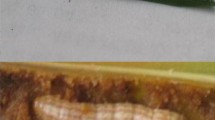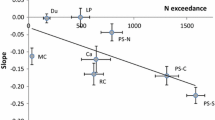Abstract
The terrestrial midge, Belgica antarctica, occupies a diverse range of microhabitats along the Antarctic Peninsula. Although overwintering larvae have the physiological potential to survive by freezing or cryoprotective dehydration, use of the latter strategy may be constrained by inoculative freezing within hibernacula. To investigate the influence of microhabitat type on larval overwintering, we selected four substrate types that differed markedly in their composition and hydric characteristics. Organic content of these substrates ranged from 14 to 89 %. High organic content was associated with higher values for saturation moisture content (up to 2.0 H2O g−1 dry mass) as well as elevated levels of field moisture content. Seasonal values of field moisture content remained near or above the saturation moisture value for each microhabitat type, and when larvae were cooled in substrates rehydrated to field-based levels, they were unable to avoid inoculation by environmental ice, regardless of substrate type. Consequently, our data suggest that wet hibernacula would force most larvae to overwinter in a frozen state. Yet, dehydrated larvae were collected in April during the seasonal transition to winter suggesting that spatial and temporal variations in precipitation and microhabitat conditions may expose larvae to dehydration and promote larval overwintering in a cryoprotectively dehydrated state.



Similar content being viewed by others
References
Allegrucci G, Carchini G, Todisco V, Convey P, Sbordoni V (2006) A molecular phylogeny of Antarctic Chironomidae and its implications for biogeographical history. Polar Biol 29:320–326
Allegrucci G, Carchini G, Convey P, Sbordoni V (2012) Evolutionary geographic relationships among orthocladine chironomid midges from maritime Antarctic and sub-Antarctic islands. Biol J Linn Soc 106:258–274
Baust JG, Edwards JS (1979) Mechanisms of freezing tolerance in an Antarctic midge, Belgica antarctica. Physiol Entomol 4:1–5
Baust JG, Lee RE (1981) Environmental “homeothermy” in an Antarctic insect. Antarct J US 15:170–172
Baust JG, Lee RE (1987) Multiple stress tolerance in an Antarctic terrestrial arthropod: Belgica antarctica. Cryobiology 24:140–147
Benoit JB, Lopez-Martinez G, Elnitsky MA, Lee RE, Denlinger DL (2007a) Moist habitats are essential for adults of the Antarctic midge, Belgica antarctica (Diptera: Chironomidae), to avoid dehydration. Eur J Entomol 104:9–14
Benoit JB, Lopez-Martinez G, Michaud MR, Elnitsky MA, Lee RE, Denlinger DL (2007b) Mechanisms to reduce dehydration stress in larvae of the Antarctic midge, Belgica antarctica. J Insect Physiol 53:656–667
Convey P, Worland MR (2000a) Refining the risk of freezing mortality for Antarctic terrestrial microarthropods. Cryo Lett 21:333–338
Convey P, Worland MR (2000b) Survival of freezing by free-living Antarctic soil nematodes. Cryo Lett 21:326–332
Costanzo JP, Moore JB, Lee RE, Kaufman PE, Wyman JA (1997) Influence of soil hydric parameters on the winter cold hardiness of a burrowing beetle, Leptinotarsa decemlineata (Say). J Comp Physiol B 167:169–176
Costanzo JP, Litzgus JD, Iverson JB, Lee RE (1998) Soil hydric characteristics and environmental ice nuclei influence supercooling capacity of hatchling painted turtles Chrysemys picta. J Exp Biol 201:3105–3112
Costanzo JP, Litzgus JD, Larson JL, Iverson JB, Lee RE (2001) Characteristics of nest soil, but not geographic origin, influence cold hardiness of hatchling painted turtles. J Therm Biol 26:65–73
Edgington ES (1995) Randomization tests. Marcel Dekker, New York
Elliot DH (1985) Physical geography—geological evolution. In: Bonner WN, Walton DWH (eds) Key environments—Antarctica. Pergamon Press, Oxford, pp 39–61
Elnitsky MA, Hayward SAL, Rinehart JP, Denlinger DL, Lee RE (2008) Cryoprotective dehydration and the resistance to inoculative freezing in the Antarctic midge, Belgica antarctica. J Exp Biol 211:524–530
Elnitsky MA, Benoit JB, Lopez-Martinez G, Denlinger DL, Lee RE (2009) Osmoregulation and salinity tolerance in the Antarctic midge, Belgica antarctica: seawater exposure confers enhanced tolerance to freezing and dehydration. J Exp Biol 212:2864–2871
Forge TA, MacGuidwin AE (1992) Effects of water potential and temperature on survival of the nematode Meloidogyne hapla in frozen soil. Can J Zool 70:1553–1560
Hadley NF (1994) Water relations of terrestrial arthropods. Academic Press, San Diego
Hayward SAL, Rinehart JP, Sandro LH, Lee RE, Denlinger DL (2007) Slow dehydration promotes desiccation and freeze tolerance in the Antarctic midge Belgica antarctica. J Exp Biol 210:836–844
Hillel D (1998) Environmental soil physics. Academic Press, San Diego
Holmstrup M, Zachariassen KE (1996) Physiology of cold hardiness in earthworms. Comp Biochem Physiol 115A:91–101
Holmstrup M, Bayley M, Pedersen SA, Zachariassen KE (2010) Interactions between cold, desiccation and environmental toxins. In: Denlinger DL, Lee RE (eds) Low temperature biology of insects. Cambridge University Press, Cambridge, pp 166–187
Kawarasaki Y, Teets NM, Denlinger DL, Lee RE (2014) Alternative overwintering strategies in an Antarctic midge: freezing versus cryoprotective dehydration. Funct Ecol. doi:10.1111/1365-2435.12229
Kennedy AD (1993) Water as a limiting factor in the Antarctic terrestrial environment: a biogeographical synthesis. Arctic Alp Res 25:308–315
Layne JR, Lee RE, Huang JL (1990) Inoculation triggers freezing at high subzero temperatures in a freeze-tolerant frog (Rana sylvatica) and insect (Eurosta solidaginis). Can J Zool 68:506–510
Lee RE, Costanzo JP (1998) Biological ice nucleation and ice distribution in cold-hardy ectothermic animals. Annu Rev Physiol 60:55–72
Lee RE, Elnitsky MA, Rinehart JP, Hayward SAL, Sandro LH, Denlinger DL (2006) Rapid cold-hardening increases the freezing tolerance of the Antarctic midge Belgica antarctica. J Exp Biol 209:399–406
Mugnano JA, Lee RE, Taylor RT (1996) Fat body cells and calcium phosphate spherules induce ice nucleation in the freeze-tolerant larvae of the gall fly Eurosta solidaginis (Diptera, Tephritidae). J Exp Biol 199:465–471
Peck LS, Convey P, Barnes DKA (2006) Environmental constraints on life histories in Antarctic ecosystems: tempos, timings and predictability. Biol Rev 81:75–109
R Development Core Team (2013) R: a language and environment for statistical computing. R Foundation for Statistical Computing, Vienna. http://www.R-project.org Accessed 15 Feb 2013
Saxton KE, Rawls WJ (2006) Soil water characteristic estimates by texture and organic matter for hydrologic solutions. Soil Sci Soc Am J 70:1569–1578
Shimada K, Riihimaa A (1988) Cold acclimation, inoculative freezing and slow cooling: essential factors contributing to the freezing-tolerance in diapausing larvae of Chymoyza costata (Diptera: Drosophilidae). Cryo Lett 9:5–10
Shoemaker VH, Hillman SS, Hillyard SD, Jackson DC, McClanahan LL, Withers PC, Wygoda ML (1992) Exchange of water, ions, and respiratory gases in terrestrial amphibians. In: Feder ME, Burggren WW (eds) Environmental physiology of amphibians. University of Chicago Press, Chicago, pp 125–150
Sugg P, Edwards JS, Baust J (1983) Phenology and life history of Belgica antarctica, an Antarctic midge (Diptera: Chironomidae). Ecol Entomol 1983:105–113
University of Wisconsin-Madison Antarctic Meteorological Research Center (2013) Palmer Station monthly weather reports. Antarctic Meteorological Research Center & Automatic Weather Station program. amrc.ssec.wisc.edu. Accessed 26 June 2013
Wheeler RE (2010) multResp lmPerm. The R project for statistical computing. http://www.r-project.org. Accessed 2 Mar 2013
Acknowledgments
This research was supported by the National Science Foundation (ANT-0837559 and ANT-0837613). We are grateful for the hard work and assistance of the support staff at Palmer Station. We also appreciate data provided by the University of Wisconsin-Madison Antarctic Meteorological Research Center (NSF Grant Number: ANT-1141908). John Bailer, Jon Costanzo, Kathleen Killian, Paul Schaeffer, and three anonymous reviewers provided critical comments and suggestions on this manuscript.
Author information
Authors and Affiliations
Corresponding author
Rights and permissions
About this article
Cite this article
Kawarasaki, Y., Teets, N.M., Denlinger, D.L. et al. Wet hibernacula promote inoculative freezing and limit the potential for cryoprotective dehydration in the Antarctic midge, Belgica antarctica . Polar Biol 37, 753–761 (2014). https://doi.org/10.1007/s00300-014-1475-0
Received:
Revised:
Accepted:
Published:
Issue Date:
DOI: https://doi.org/10.1007/s00300-014-1475-0




